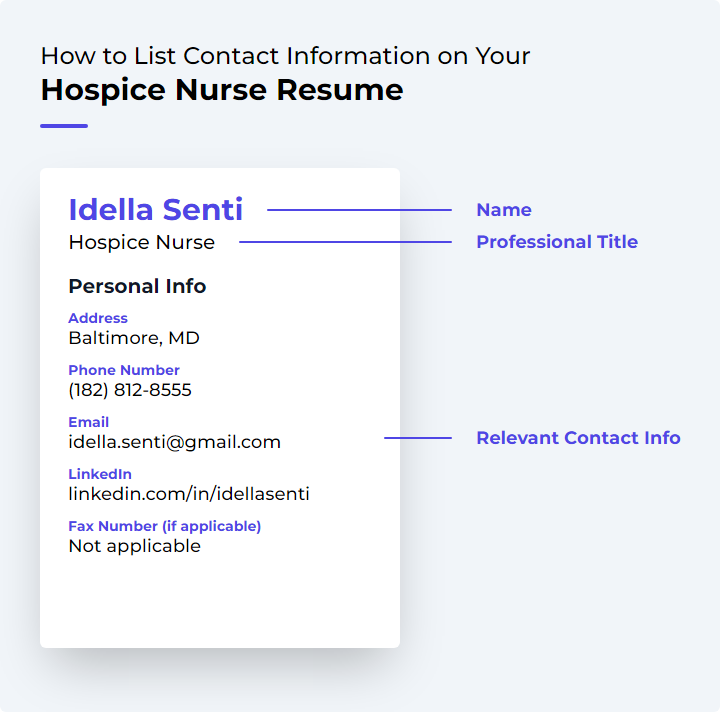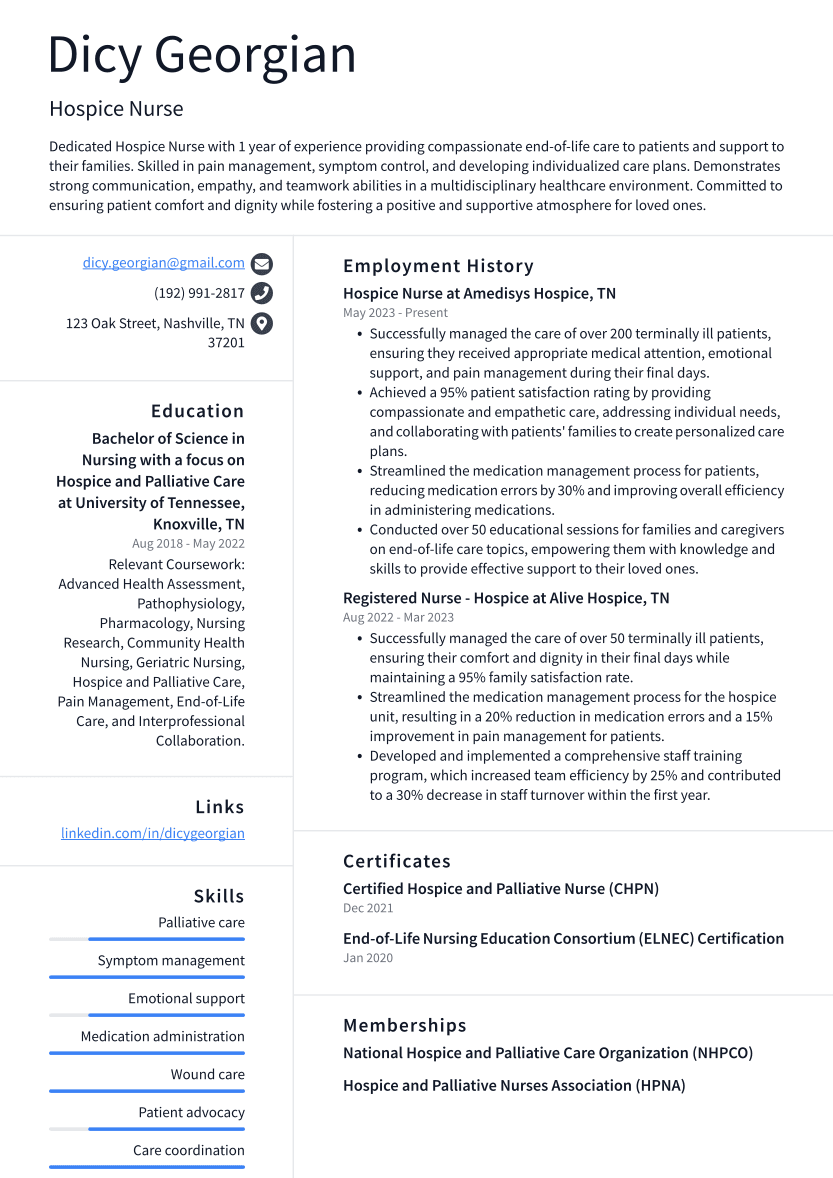Hospice Nurse Resume Examples
Writing a great hospice nurse resume is important because it is one of the first things a potential employer will see when they are considering you for a position. It is your opportunity to make a good first impression and sell yourself as the best candidate for the job.
Create your resume
Select from 7 professional resume templates
If you're looking for inspiration when it comes to drafting your own hospice nurse resume, look no further than the samples below. These resumes will help you highlight your experience and qualifications in the most effective way possible, giving you the best chance of landing the hospice nurse job you're after.
Essential Components of a Hospice Nurse Resume
A hospice nurse's resume is a critical instrument for showcasing expertise, experience, and qualifications. It serves as the initial point of contact with potential employers and must be meticulously crafted to highlight the candidate's suitability for providing compassionate end-of-life care, symptom management, and emotional support, among other pivotal responsibilities of hospice nursing.
Below, we delve into the various segments of a hospice nurse resume, discussing the content of each, their significance, and strategies to make them stand out to prospective employers.
1. Contact Information
The "Contact Information" section is crucial for any resume, including that of a hospice nurse. It allows prospective employers to reach out for further discussions or interviews and should be prominently placed at the top of the resume.

Include your full name, phone number, and a professional email address—preferably one that incorporates your first and last name. Avoid using personal or outdated email accounts.
While a full home address is not necessary due to privacy concerns, listing your city and state can be beneficial. Employers may have location preferences or offer relocation assistance.
Modern resumes may also feature links to professional networking sites like LinkedIn. Ensure that your public profile aligns with your professional image.
Remember, accurate and up-to-date contact information is vital; without it, your qualifications cannot be leveraged if employers are unable to reach you.
2. Professional Summary or Objective
The resume should begin with a compelling Professional Summary or Objective that acts as a preview of your skills, experiences, and career goals. This section should capture the attention of potential employers immediately.
Highlight your hospice care expertise, including:
- Providing end-of-life care
- Managing symptoms of terminal illnesses
- Offering emotional support to patients and their families
- Collaborating with healthcare teams
An objective might state: "Compassionate Registered Nurse with over 5 years of experience in hospice settings, seeking a position to utilize my patient care skills and collaborative abilities with patients, families, and healthcare staff."
Conversely, a professional summary could read: "Dedicated Hospice Nurse with 7 years of experience in providing comprehensive end-of-life care, maintaining patient dignity, and delivering high-quality palliative care. Demonstrated success in working with diverse medical teams."
Customize this section for each job application, emphasizing the skills and experiences that align with the job description.
Related: Top Hospice Nurse Resume Objective Examples
3. Skills and Competencies
The "Skills and Competencies" section is a showcase of the unique abilities and personal qualities that qualify you for the sensitive role of a hospice nurse. It should include a balance of technical and soft skills essential for comprehensive patient care at the end of life.
- Clinical Skills: Proficiency in pain management, medication administration, wound care, respiratory care, and understanding of terminal illnesses.
- Communication Skills: Effective verbal and written communication with patients, families, and healthcare professionals, coupled with excellent listening skills.
- Emotional Strength: The capacity to cope with the emotional demands of working with terminally ill patients and their families.
- Compassion & Empathy: Deep understanding and sensitivity to the needs of patients in the most vulnerable stage of their lives.
- Organizational Skills: Ability to manage multiple patient cases, keeping track of medical records, medications, and appointments.
- Critical Thinking & Problem-Solving Skills: Quick and effective decision-making in emergency situations or when a patient's condition deteriorates.
- Cultural Sensitivity: Respect for diverse perspectives on death and dying.
- End-of-Life Care Knowledge: Expertise in palliative care and end-of-life decision-making.
- Patient Advocacy: Championing patients' wishes and preferences regarding treatment and quality of life.
- Flexibility & Adaptability: The ability to adjust to sudden changes in patient needs or care plans.
While listing these skills is important, providing real-life examples where you've demonstrated them will strengthen your resume.
Related: Hospice Nurse Skills: Definition and Examples
4. Work Experience
The "Work Experience" section is a critical component of a hospice nurse's resume, offering potential employers a glimpse into your past roles, responsibilities, and achievements within the field. This section should underscore your proficiency in delivering end-of-life care, managing symptoms of terminal illnesses, and providing emotional support to patients' families.
Detail your work history, including the organizations you've worked for, dates of employment, and specific responsibilities and duties. Highlight tasks such as:
- Administering medications
- Collaborating on care plans with healthcare professionals
- Providing physical care and emotional counseling
- Educating families on end-of-life care
Emphasize any special projects or initiatives, such as developing new patient-care protocols or leading efforts to improve patient satisfaction. Quantifiable achievements, like reducing hospital readmissions, can make your resume stand out.
Customize this section to reflect the job description, highlighting relevant skills and experiences.
5. Education and Certifications
The "Education and Certifications" section is fundamental to your hospice nurse resume. It showcases your academic achievements, specialized training, and certifications that qualify you for the role.
List your nursing degree, whether it's a Bachelor of Science in Nursing (BSN), an Associate Degree in Nursing (ADN), or a higher degree like a Master's in Nursing (MSN). Include your licensure status, such as passing the National Council Licensure Examination (NCLEX-RN), and any state-specific licenses.
Highlight certifications like the Certified Hospice and Palliative Nurse (CHPN) credential, which can enhance your resume. Mention any additional training or courses in palliative care or related fields, and include graduation or certification dates to demonstrate the currency of your qualifications.
This section is crucial for establishing your competence as a hospice nurse, so ensure all relevant educational credentials and certifications are clearly listed.
Related: Hospice Nurse Certifications
6. Licenses and Registrations
The "Licenses and Registrations" section is essential, confirming your legal qualification to practice as a hospice nurse and your professional expertise. Ensure you're familiar with the licensing requirements in your state.
All hospice nurses must be Registered Nurses (RN), having completed an accredited nursing program and passed the NCLEX-RN. Include your RN license details, such as the license number and issuing state, on your resume.
Additional certifications, like the CHPN, should be listed here. If you hold advanced qualifications, such as being an Advanced Practice Registered Nurse (APRN), include these as well.
- Maintain current licenses and registrations, and renew them before job hunting to avoid presenting outdated credentials to potential employers.
This section demonstrates your professional capability and commitment to quality end-of-life care, highlighting your specialized knowledge in hospice nursing.
7. References
References are a valuable addition to your hospice nurse resume, attesting to your professional skills, experience, and fit for the role. Choose references who can speak to your abilities and character, such as former supervisors, colleagues, or educators.
With their consent, list their name, job title, organization, contact information, and your relationship to them (e.g., "Former Supervisor at XYZ Hospice").
Obtaining permission from your references allows them to prepare for potential inquiries and ensures they are willing to provide positive feedback.
While references are typically contacted later in the hiring process, having strong endorsements ready can distinguish you from other candidates. If preferred by the employer, simply note "References available upon request" at the end of your resume.
Select references who are familiar with your professional conduct and can confidently discuss your qualifications as a hospice nurse, aligning their insights with the job requirements.
